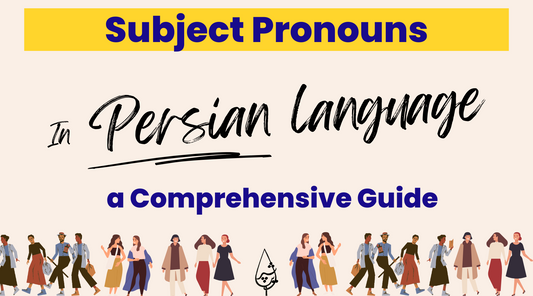Whether you're navigating a friendly chat or composing formal written texts, understanding subject pronouns is key.
Personal pronouns are the handy words we use to replace nouns when they take on the role of the sentence's subject.
Subject Pronouns Demystified
Now, you might be wondering, why even bother with these pronouns? Well, here's the magic: they make sentences shorter and less repetitive. In the English language, we have some trusty subject pronouns in our toolbox, including "I," "you," "he," "she," "it," "we," and "they."
Let's illustrate this with an example:
"Meet Shirin. She's Iranian and she firmly believes that throwing away tahdig is a culinary sin."
In this instance, I've swapped out "she" for "Shirin" to keep our sentence concise and to avoid unnecessary repetition."
Similar to English, there are six subject pronouns in Persian that vary in number and person.
In Persian, the use of subject pronouns in optional rather than mandatory since the person of a verb is marked at the end of verbs.
For example, the /am/ at the end of ميروم/miram/ clearly signals that the person carrying out the action is I /man/ , thereby making the use of the subject pronoun من depending on the context is either redundant or phor emphasis on the doer of the action of going.
📚 Singular Pronouns:(
1️⃣ من (man) - "I"
2️⃣ تو (to) - "You" (informal)- شما (shomā) - "You" (formal and polite)
3️⃣ او (u) - "He/She"- (u) - آن (ān)- “it/that”
ايشان (ishān) she/he/ they in polite language
Personal pronouns First and second persons, sg./pl.: no change! (شما/ما/تو/من remain unchanged.) There are changes in the third person: او) he/she) and آن) it/that) both change to اون) un, he/she/it/that); آنها) they/those) changes to اونا) unA); ايشان) he/they in polite language) changes to ايشون) ishun).
📚 Plural Pronouns:
1️⃣ ما (mā) - "We"
2️⃣ شما (shomā) - "You"
3️⃣ آنها (ānhā) - "They"
🔍 Usage Tips:
- Use من for "I" when talking about yourself.
- تو is an informal "You" mainly used among friends and close acquaintances.
- شما is the formal or plural "You," suitable for addressing strangers, elders, or groups.
- او refers to "He" or "She," depending on the gender of the person you're talking about.
- ما represents "We," denoting a group that includes yourself.
- آنها stands for "They," used to refer to multiple individuals.
Save this helpful table:

Some notes;
What is the concept of this polite thing?
Spanish Speakers (I don't know about other languages) are more familiar with this concept. They have a pronoun 'usted' with the same meaning as /shomā/.
When it comes to addressing one person, whether it's he, she, it, or you (singular), you use /shomā/ and /ishun/.
Plural means Polite:
/to/ 👉🏼 polite👉🏼 /shomā/
/un/👉🏼 polite👉🏼/ishun/
Context:
/shomā/: Anyone except your close friends and plants:
Parents (except when you're not sober), strangers, coworkers, neighbor, neighbor's cat (seriously, you build an unbreakable rapport with the owner), grandparents, boss, doctor, police officer, etc.
/ishun/: for the same people mentioned above, when you're talking behind their back while being polite, or when they're already there. Example:
Imagine, you brought your girlsfriend for the first time to a family /mehmuni/ (party) and you want to introduce her to your Amu (Uncle):
-ishun dust-dokhtar-am hastan.ایشون دوستدخترم هستن
(She's my girlfriend)
-bah, bah, khoshvaghtam! بهبه! خوشوقتم.
(great, please to meet you)
You might ask;
Should I use my verbs plural for /shomā/ and /ishun/?
Grammatically, it is correct to use verbs in plural forms, because well, your subject pronoun IS plural. However, some Iranians use singular verbs, especially for /shomā/, when that person they are addressing as /shomā/ is not that /shomā/. It's just a young coworker in their 20's that they want to be polite to but not treat them as a senior. That's it.
She, He, It are the same in spoken Persian as 'un' اون
As you might have probably noticed, Persian provides with two options when referring to the second person singular and the third person singular. The pronouns and تو are ايشان the informal forms of addressing You and They , whereas شما and ايشان are the
formal forms of the same pronouns.
Finally, Persian only has one pronoun form (او ( that corresponds to he, she and it
in English. In other words, Persian has no grammatical gender distinction, in
nouns, pronouns, or adjectives.
So,

Remember: Learning personal pronouns is a fundamental step towards mastering Persian conversation. Keep practicing, and you'll soon become a confident communicator!
Attention: Notice to distinguish pronunciation of ‘ā’ (like a in bar) and a in cat. Sometimes it eads you to a mistake that I hope is totally understandable for your Persian fellows, but better to know it because you need to be a good ‘listener’ first so knowing right pronunciation make you an independent learner. For your information, well, ‘māst’ماست means yogurt, ‘mast’ مَست means ‘drunk’. so , it’s a good investment to train yourself realize the differences.
🔗 Sign up for newletter for more Persian language tips and lessons. Happy learning!




